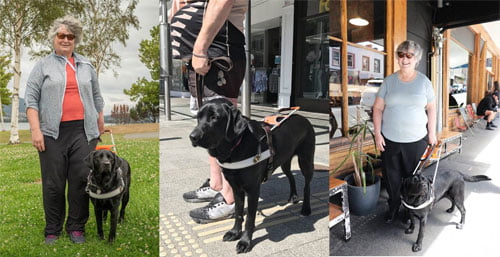 COVID-19 has changed the way we do things across the community. Physical distancing can be awkward at the best of times, but when you can’t see the signs things get complicated. We asked some of our Guide Dog handlers about their experiences.
COVID-19 has changed the way we do things across the community. Physical distancing can be awkward at the best of times, but when you can’t see the signs things get complicated. We asked some of our Guide Dog handlers about their experiences.
Wayne Pollard and his Guide Dog Elly from Northern Tasmania have experienced some of these challenges when out in their local community.
“There have been a few challenges for Elly and I, like going into a shop through barriers one way and coming out a different way. I can’t expect Elly to work that out by herself, so I sometimes have to ask for help.
Buses have also been confusing because most people are entering from the back and not the front. Thankfully last time I caught a bus the people at the bus stop and the bus driver said I could get on in the front with Elly. Most people in the community have been understanding if Elly and I walk past closely. I did have one person ask me why I was so close? I explained that Guide Dogs aren’t trained to stay 2 metres away. Most people have been good”.
Anne and Billie
Anne Jackson and her Guide Dog Billie from Hobart also have come across challenges out in the community. Travelling in lifts present their own problems. A Guide Dog is trained to move to the back of the lift, then spin around so the dog and handler are facing the door. Any arrows on the floor aren’t seen by the handler or the dog and therefore impacts social distancing in elevators.
“Billie is learning the new way of life pretty quickly – for example she has waited patiently for me to have my temperature taken before entering some buildings”.
Her biggest faux pas is not understanding the 1.5 metre social distancing rule. A few shoppers have made angry comments about us being too close. This hasn’t happened very often. She seems to be forgiven by the majority when we breach it.
Anne Jackson, Guide Dog handler.
“Lifts are a particular problem with this as neither of us seem to be able to count to two re the maximum number of people in a lift”.
What can you do to help?
- Give the handler and their Guide Dog space.
- If the handler looks like they need some help, be sure to ask them, although never touch them or their dog without permission.
- Be courteous and understanding if a Guide Dog and their handler accidentally come close to you when walking nearby. Guide Dogs are trained to avoid obstacles including people, however sometimes they may naturally walk closely past people as they navigate their way ahead. For good reasons Guide Dogs aren’t trained to always maintain 1.5 metres distance so please forgive the Guide Dog and their handler if they get a little close to you, it usually shouldn’t last long and if you simply give them a little extra space they will stay out of the way.
Tips for store owners:
- Use high contrast signs placed at eye height so those with low vision.
- Once the layout is changed, please don’t keep changing it. It is very difficult to memorise a layout if it is different each time.
If you are a business or corporation and would like to improve the accessibility of your website, documents or physical spaces, please get in touch with our Accessible Information Team.
We are a leading provider of Guide Dog services to people who are blind or vision impaired.
Contact us to speak to a friendly staff today about our Guide Dog program (link opens in new window).
